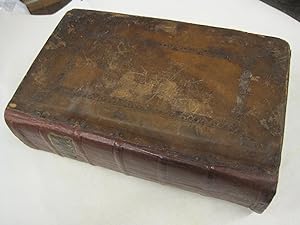About this Item
Quarto-sized volume measuring approx. 11x7x3 inches, bound in full panelled calf of the period, at some time rebacked in full leather with 5 raised bands, remnants of old spine label in the second compartment; binding square and tight, old signature of "Edw. Ayscoght" on front pastedown and of "W. Hoghton" at top of first title page. Internally quite clean, occasional light age toning and very slight marginal dampstaining, contemporary notations to a very few leaves. The important act is paginated: title page, verso blank, (187)-202, blank leaf. "The Bill of Rights, also known as the English Bill of Rights, is an Act of the Parliament of England that sets out certain basic civil rights and clarifies who would be next to inherit the Crown. It received the Royal Assent on 16 December 1689 and is a restatement in statutory form of the Declaration of Right presented by the Convention Parliament to William III and Mary II in February 1689, inviting them to become joint sovereigns of England. The Bill of Rights lays down limits on the powers of the monarch and sets out the rights of Parliament, including the requirement for regular parliaments, free elections, and freedom of speech in Parliament. It sets out certain rights of individuals including the prohibition of cruel and unusual punishment and reestablished the right of Protestants to have arms for their defence within the rule of law. Furthermore, the Bill of Rights described and condemned several misdeeds of James II of England. These ideas reflected those of the political thinker John Locke and they quickly became popular in England. It also sets out ? or, in the view of its drafters, restates ? certain constitutional requirements of the Crown to seek the consent of the people, as represented in Parliament. . . The Bill of Rights (1689) reinforced the Petition of Right (1628) and the Habeas Corpus Act (1679) by codifying certain rights and liberties. Described by William Blackstone as Fundamental Laws of England, the rights expressed in these Acts became associated with the idea of the rights of Englishmen. The Bill of Rights directly influenced the 1776 Virginia Declaration of Rights, which in turn influenced the Declaration of Independence." It thus formed the intellectual basis of the American Constitution, the United States Bill of Rights, the French Declaration of the Rights of Man and of the Citizen, the United Nations Universal Declaration of Human Rights and the European Convention on Human Rights. Other acts in the volume serve to broaden our understanding of the temper of the times in England, a period of political and social upheaval of the Glorious Revolution. These ideals were manifest inf the French Revolution as well. It was the key piece of legislation in forming the intellectual foundation of a new relationship between the government and the governed in many parts of the world in subsequent times. If you wish further information on the presence of any other specific acts, please feel to inquire.
Seller Inventory # 021338
Contact seller
Report this item




